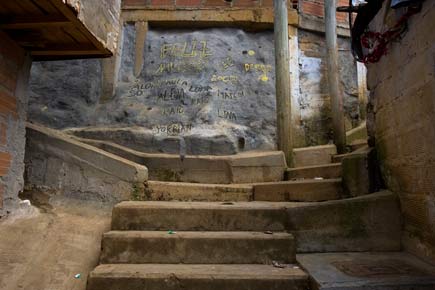ARTEXT : La Biennale di Venezia
54 Esposizione Internazionale d'Arte
Arsenale - Artiglierie
ENTRE SIEMPRE Y JAMAS
Juan Fernand Herrán
A longing to reach and conquer a territory, sometimes achieving that and often failing-perhaps the best way to represent Latin American is as an unfinished road. Is this what America is like? Some people would say so. Oh these poor people, others would say so. Oh these poor people, others would conclude. So many stairs to climb just to get homes. How awful. But nevertheless, beyound the concern about its difficulty, the important thing is the gesture-wanting to get there no matter what it takes. Seen in this light, this long, contradictory, impossible. Escher-like roads are transformed into pubblic sculptures, representations of the passage from the private to the public, from destitution to poverty, from the land to concrete, access to many places we didn't think existed. The stairs exibit universes and the colonization of a space. Its conquest. Although stairways are also part of our reality, we don't usualy look so closely at them. Our gaze is broad and general, too broad and too general. We barely see the thousands of litle self-built houses hanging threads like promises of something to be completed.
We accept these space beyound the walls of cities as a frozen ensemble.
But these first shots by Juan Fernando Herreràn (Bogotà, 1963) reveal a complex network of individual and unique relationships. Each step signifies a world and sesks to attaint it. Herràn stops to look at a house called the "central nave", a strainway propped up in the middle of a vacant and apparently unstable wooden building. This is neither irony nor a road to nowhere. The name gives it an almost mystical meaning, since the central naves refers to the middle of a church of temple. Everything starts from this foundational step.
Then there are "Grave", "Passageway" and "Connection", there popular ways to appropriate the stairway. The first goes nowhere, it is simply the dream than it could lead to a future. But it never comes true. The second is an unknown, an apparent dead end, an enchanting disorder full of symmetry, the use of space to the very end. The last a conquest, the achievement of bricks and cement, the promise of a second floor to come, the road leading to the real wooden base, the triumph of social mobility.
Escales (Steps) arose from the observation of a reality that jumps out at you: this is a landscape that is becoming permanent. And then from an interpretation from his thinkings about the legacy of the Bicentenary of indipendence celebrated in so many Latin American countries last year. This unfinished reality, halway between longing, and the shock of a hard-to-change reality, turned out to be the ideal combination to demonstrate the legacy of two hundred years of freedom. "In the end, all this zonatily. The need for one's own place is more important than anything else".
Alfons Hug, twice curator of the Sao Paulo biennal and this year curator of the Latin American Pavilion at the Venice Biennale, took an interest in this idea of the Colombian artist because he had wanted to give particular emphasis to the Bicentennial celebrations and the idea of formulating a "continental cultural plan".
Juan Fernando Herman is above all a scultor who points out gestures. His work reveals the marks of their days and dreams that people leave behind. That quest to build, even two hundred years later, their heaven, a palpablr heaven made of earth. D.R.D.
Entre Siempre y Jamás cita a un poema del escritor uruguayo Mario Benedetti indicando la distancia entre la tradición de fechas notables en la historia y la contemporaneidad. De este modo, recuperamos un significado complejo de la Independencia articulando sus ecos temporales y locales a través del arte contemporáneo.
Esta exposición se presenta con artistas de veinte países latinoamericanos y constituye la contribución del Pabellón América Latina – IILA (Instituto Italo-Latino Americano) en la 54. Esposizione Internazionale d'Arte - la Biennale di Venezia.
Entre Siempre y Jamás es la continuación del proyecto Menos Tiempo que Lugar que investigó el Bicentenario de la Independencia de América Latina a través de una serie de exposiciones realizadas en más de 15 ciudades del continente durante 2009 y 2010.
Por un lado, la exposición ofrece una cartografía continental, pues obedece a una dramaturgia geográfica y permite que diferentes países de Latinoamérica desfilen ante nosotros. Por otro lado, traza un haz de tiempo que explora la historia palpándola año a año. Lo que así surge es un “cronotopo”, o sea la unidad indisoluble de tiempo y espacio.
Curatore :Alfons Hug
Artista : Leticia El Halli Obeid , Narda Alvarado, Neville D’Almeida, Sebastián Preece, Juan Fernando Herrán , Sila Chanto, Reynier Leyva Novo, María Rosa Jijón, Walterio Iraheta, Regina José Galindo, Adán Vallecillo, Julieta Aranda, Rolando Castellón, Claudia Casarino, Fernando Gutiérrez, David Pérez Karmadavis, Martín Sastre, Alexander Apóstol,
Alberto Maria de Agostini, Gianfranco Foschino, Christine de la Garenne, Olaf Holzapfel, Mirta, Dionisia, Noelia e Luisa Gutiérrez, Björn Melhus
Web site: http://www.iila.org |

